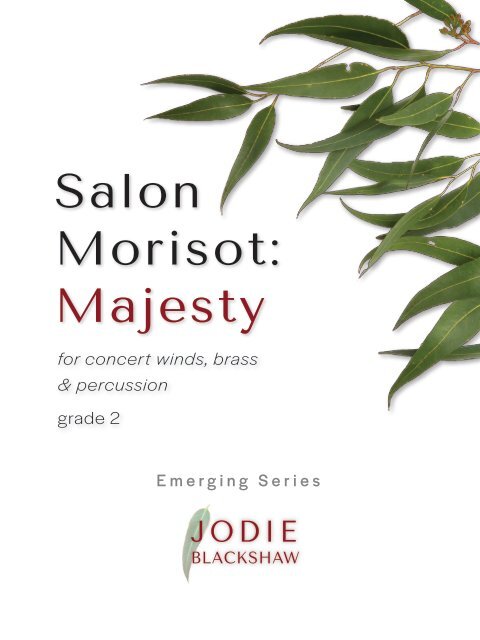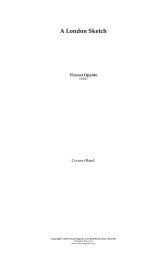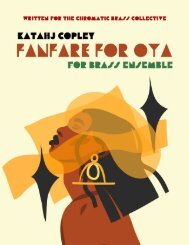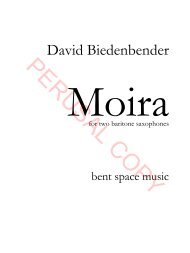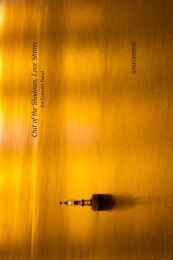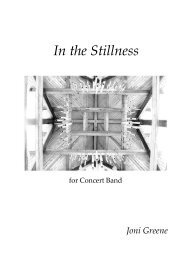Majesty-Jodie Blackshaw
Create successful ePaper yourself
Turn your PDF publications into a flip-book with our unique Google optimized e-Paper software.
Salon<br />
Morisot:<br />
<strong>Majesty</strong><br />
for concert winds, brass<br />
& percussion<br />
grade 2<br />
Emerging Series<br />
JODIE<br />
BLACKSHAW
TEACHING PERFORMANCE THROUGH COMPOSITION<br />
APPROACHABLE – ENGAGING - FLEXIBLE<br />
The Teaching Performance through Composition series brings<br />
composition opportunities to your ensemble with ease.<br />
Try a Rhythm & Pitch pack to get you started!<br />
Teaching Performance through Composition<br />
Teaching Performance through Composition<br />
Teaching Performance through Composition<br />
Rhythm & Pitch<br />
Package #2<br />
Fruit smoothie<br />
Rhythm & Pitch<br />
Package #3<br />
Running to the Station<br />
Rhythm & Pitch<br />
Package #4<br />
Do you dare?<br />
Beginner Series<br />
JODIE<br />
BLACKSHAW<br />
Beginner Series<br />
JODIE<br />
BLACKSHAW<br />
Beginner Series<br />
JODIE<br />
BLACKSHAW<br />
Teaching Performance through Composition<br />
Rhythm & Pitch<br />
Package #5<br />
Sing to me<br />
Emerging Series<br />
JODIE<br />
BLACKSHAW<br />
Books One-Four in the series are available through Murphy Music Press Incorporated.<br />
http://murphymusicpress.com/<br />
Individual purchases of selected resources in PDF along<br />
with professional development packages available at<br />
jodieblackshaw.com<br />
© ColourFULLM usic 202 2
<strong>Majesty</strong><br />
F O R C O N C E R T W I N D S , B R A S S & P E R C U S S I O N<br />
JODIE BLACKSHAW<br />
INSTRUMENTATION<br />
Flute<br />
Oboe<br />
Clarinet 1 & 2 in B¯<br />
Bass Clarinet in B¯<br />
Trumpet 1 & 2 in B¯<br />
French Horn in F<br />
Trombone/Baritone/Bassoon<br />
Tuba<br />
Alto Sax in E¯<br />
Tenor Saxophone in B¯<br />
Keyboard<br />
Timpani (optional)<br />
Baritone Saxophone in E¯<br />
Percussion Requirements<br />
Mallets 1: Glockenspiel<br />
Mallets 2 & 3: Vibraphone/Bells<br />
Percussion 1, 2, 3<br />
Triangle, Cymbal(s), Bass Drum<br />
©2022 ColourFULL Music. All rights reserved.<br />
International rights secured.<br />
www.jodieblackshaw.com
Salon Morisot: <strong>Majesty</strong><br />
Devotion is the second movement of a threemovement<br />
suite entitled Salon Morisot (the<br />
Morisot Exhibition). Each movement is<br />
inspired by a Berthe Morisot painting that<br />
were created between 1869-1884. Morisot<br />
was torn between her passion for art and the<br />
desire to marry and become a Mother. It is<br />
this tension that forms a central theme to the<br />
entire suite.<br />
T REHEARSAL NOTES T<br />
I – The Harbor at Lorient<br />
The first movement ‘<strong>Majesty</strong>’ is inspired by<br />
the artwork ‘The Harbor at Lorient’, painted in 1869. The artwork beautifully captures the reflective nature of water and<br />
features a lone female figure observing the grandeur of the tall ships. The woman is her sister Edma, who had recently<br />
married and moved away from the family home. The sisters were both avid painters and consequently were very close.<br />
They found their separation very difficult. Hence in this movement, I have attempted to capture not only the majesty of<br />
the ships, but the profound sense of loss as displayed by the sole woman sitting on the wall.<br />
II – Devotion<br />
In 1873 Morisot painted ‘The Cradle’, again representing her sister Edma with a new born infant. The baby is<br />
Edma’s little girl Blanche, Berthe’s niece. Again, the painting represents tension. This can be found in Edma’s<br />
expression and how she holds her fingers in her right hand. The<br />
juxtaposition of the light background behind her sister and the dark<br />
background surrounding the bassinet may also suggest the inner battle<br />
both sisters contended regarding societal expectations and their artistic<br />
pursuits. In this movement I have attempted to capture the thoughts of<br />
Edma Morisot at this time – joy, apprehension, hope and pure love<br />
whilst also capturing Berthe’s anxieties regarding marriage.<br />
III – Enchantment<br />
The third movement brings about a release from the tension. ‘The<br />
Garden at Bougival’ represents the changes that occurred in Berthe’s<br />
life in the decade<br />
following ‘The<br />
Cradle’. She married<br />
Eugene Manet,<br />
Édouard’s younger brother, in late 1874. Eugene was himself<br />
a painter but gave up his pursuits to support Berthe, thus<br />
relieving her inner struggle. The Manet’s expanded their<br />
family in 1878 with the birth of a baby girl, Julie. From 1881-<br />
1884 the Manet’s predominantly lived in Bougival. They<br />
were very happy there and thus the music in ‘Enchantment’<br />
is strikingly different, representing not only the whimsical<br />
change in painting style but also Berthe’s newfound love<br />
brought about by marriage and motherhood.<br />
i
Providing context: a brief art history lesson regarding Impressionism<br />
From 1648 to 1881 the most prestigious annual art exhibition in France was the Paris Salon (a salon being an<br />
exhibition). Thousands of artists sent paintings for consideration and acceptance (and thus exhibition) paved the<br />
successful careers of many painters. However; the French Academy of Fine Art was embedded in the Neo-<br />
Classicist style and in time, their increasingly parochial parameters brought labels such as ‘academic’ to describe<br />
their preferred artistic approach. The Academy’s resistance to change came to a head in 1863 when almost 3000<br />
artworks were rejected for the forthcoming Paris Salon. Artists such as Édouard Manet appealed to the Emperor<br />
of France, Napoleon III to have the Academy reconsider their parameters for the Paris Salon. Their efforts were<br />
rewarded with a second public exhibition entitled the Salon des Refusés (exhibition of rejected art). The public<br />
turned out in their thousands to view the refused artwork and whilst their opinion was varied, the result was an<br />
acknowledgement of a new avant-garde movement in French art. This movement is what we now call<br />
Impressionism and it was Impressionism that brought about the dissolution of the Academy of Fine Art in 1881.<br />
1874 brought the very first Impressionist Salon featuring works by Claude Monet, Edgar Degas, Pierre-Auguste<br />
Renoir, Camille Pissarro and one woman, Berthe Morisot. Morisot had dedicated her life to painting and had<br />
been fortunate to have some works exhibited in the Paris Salon from an early age. However; her subject matter<br />
represented her surroundings and as a woman, these were dominated by other women and children. This subject<br />
matter was viewed as common and unimportant and as a result, her works were often overlooked. That said,<br />
Morisot was held in high regard by her artistic colleagues, in particular, Édouard Manet. All of the ‘masters’<br />
owned Morisot originals (Claude Monet owned 5) and there are particular schools of thought that suggest that<br />
her experimentation significantly influenced the ongoing development of the Impressionist style that culminated<br />
with the famous ‘Waterlily’ collection by Claude Monet.<br />
Educational goals<br />
There are two central education goals that govern the entire work:<br />
1. Learning to hear harmonic changes<br />
In each of the three movements the same melodic material is repeated over an ever-changing harmonic<br />
landscape. These changes become increasingly more complex as the suite progresses and invites students<br />
to hold onto their melodic parts even when the harmonic movement changes.<br />
2. Releasing sound with care<br />
In the second and third movements of the suite, a new form of notation is introduced (see below). The<br />
fading notation is designed to encourage your students to consider how they release their sound during a<br />
piece. It is not to represent ‘niente’, but to invite the<br />
student to decrescendo and gently release their sound so<br />
that their release isn’t noticeable. You can teach this to<br />
your students using their voice first with the humming<br />
that exists at the beginning and end of the second movement. Students are encouraged to start with a<br />
hum, gradually move to an ‘ooo’ sound then back to a hum and gently release. If your group is small<br />
enough, do this with everyone standing in a circle. Can they tell when the students around them have<br />
released their sound? Who will be detected and who will not? It’s as much a listening activity as it is of<br />
breath control.<br />
Key Signatures<br />
Each movement does not use key signatures, accidentals are employed instead. This provides you, the director,<br />
an opportunity to discuss key signature with your students and based on their accidentals, discover what key<br />
they think each movement is based on.<br />
ii
Conductor’s Notes<br />
<strong>Majesty</strong><br />
1. Percussion 3: this should be one of your strongest percussionists because the part is so exposed. Concert<br />
marimba is the preferred instrument here, or a Bass Xylophone.<br />
2. Trombone: there is a focus in this movement for the trombone players to embrace a “Study” on moving<br />
between the 3 rd and 4 th slide positions. Seat them near the Bassoons (if you have them) in this movement,<br />
it will help them find and hold their pitch.<br />
3. Keyboard: this part has been included to provided a strong tonal centre for the whole ensemble to refer<br />
to. Hence, a solid, non-wavering string ensemble sound on a keyboard is asked for. This can be played<br />
by a student new to ensembles who is confident with keyboard – it will give them the opportunity to get<br />
used to working with others whilst learning to follow a conductor.<br />
4. At measure 49 a cue has been placed in the Trumpet part. If you feel your clarinetists cannot work out<br />
how to play their written ‘A’ in tune by adding additional fingers in the right hand, then it may work<br />
better for your ensemble to use trumpet. I don’t mind either way J<br />
5. Intensity is key in this movement, as is momentum. It is vital that the ensemble dynamic moves<br />
progressively and isn’t too loud, too soon. Hold back until the measures 37-48. To quote Tim Reynish<br />
‘If it is always loud it never gets exciting’. Let this movement become exciting!<br />
Educational Goal #1: Learning to hear harmonic changes<br />
In Movement 1, the melodic material first represented by Flute, Oboe, Bassoon and Trombone overlays two<br />
moving chords - G and F. Over the G centre, the melodic material sits in the third of the chord, whilst over F the<br />
concert B natural becomes a tension, a diminished fourth (tritone) that resolves to the major third. Articulate this<br />
to your students and ask them to embrace the tension, not shy away from it. This will enable stronger intonation<br />
and help them hear the simple changing harmonic structure.<br />
At measure 41, the piece lands in E¯ major and the same melodic figure now sits in the 5 th of the chord providing<br />
resolution and another harmonic change. Teaching students about where their part sits in the voicing of the chord<br />
is empowering and enhances their listening.<br />
French directions<br />
All score directions are given in French to provide vocabulary extension and embrace the French theme. Here<br />
are the translations for your convenience:<br />
<strong>Majesty</strong> French English<br />
Measure 1 Avec une intensité croissante With increasing intensity<br />
Measure 49 Pacifiquement Peacefully<br />
Measure 56 très ralentissez Molto Rit.<br />
COMMISSION<br />
This work was commissioned by Clarkston Schools Instrumental Music Association in recognition of Shelley<br />
Schwaderer Roland's many years of dedication to the Clarkston School Music Program and the University of<br />
Wisconsin (Eau Claire), Director of Bands, Dr. John Stewart.<br />
My sincere gratitude is extended to Justin Harris for his patience and support throughout the compositional<br />
process and also to Dr. John Stewart for his continued encouragement and grace.<br />
iii
T PROGRAMME NOTES T<br />
"Salon Morisot" is a suite of three miniatures that are inspired by the remarkable artistry of little known female French impressionist<br />
artist, Berthe Morisot (1841-1895). Morisot was highly admired by her fellow Impressionist colleagues and her works were exhibited<br />
in the very first (and many consequential) Impressionist ‘Salon’ of 1874 (a Salon being an exhibition). Many famous artists held an<br />
original Morisot artwork in their private collections including Manet, Monet, Degas and Pissaro. Morisot married Édouard Manet’s<br />
younger brother Eugene Manet and her painting styles are regarded as a driving force behind the Impressionist style.<br />
The three miniatures in this program are inspired by three Morisot artworks that depict a particular period in her life.<br />
<strong>Majesty</strong>: inspired by the painting ‘The Harbor at Lorient’ (1869).<br />
The Harbor at Lorient" features Morisot’s sister Edma and tall ships. Edma and her sister were very close. She had not long been<br />
married and they missed each other terribly. Hence, I have attempted to capture not only the grandeur of the tall ships but to also reveal<br />
the despair and heartbreak felt by both sisters at this time. It is my desire that the harmonic tensions reveal their hidden emotions whilst<br />
maintaining an element of calm on the surface.<br />
T ABOUT THE COMPOSER T<br />
Have you ever played a ‘<strong>Blackshaw</strong>’ with your wind ensemble? If you have, then you know that a work by this Australian composereducator<br />
is different from the norm. You will also know that it takes you, the Director, on an alternate educational pathway that for<br />
some, is a little uncomfortable at first. That said you would also know that it is a surprise package, an audience favourite and presents<br />
you the director with interesting conducting challenges.<br />
Such is the work of <strong>Jodie</strong> <strong>Blackshaw</strong>.<br />
<strong>Blackshaw</strong> is also renown as an advocate for performance equality. In 2017 <strong>Jodie</strong> launched a Female Band Composer database on her<br />
website that focuses on works for middle and high school bands (www.jodieblackshaw.com/female-band-composers). In late 2018,<br />
she headed a presentation called “Directors for Diversity” at the Midwest Clinic, Chicago USA. “Directors for Diversity” inspired the<br />
birth of another online resource; ColourFULL Music (https://www.colourfullmusic.com). The ColourFULL Music website includes<br />
concert programs for bands of all capabilities that are inclusive of composers from a diverse background of nationality, age and gender.<br />
<strong>Blackshaw</strong> is fanatical about producing quality, meaningful works for band and is frequently commissioned by various groups<br />
throughout the western world to do just that. She desires that her music not just be "another piece, but an educational and spiritual<br />
journey for both the players and the director". To find out more about <strong>Jodie</strong> and her works please go to: www.jodieblackshaw.com<br />
iv
For Shelley<br />
Portrait of Berthe Morisot entitled<br />
“Berthe Morisot with a bouquet of flowers”<br />
by Édouard Manet, 1872<br />
v
This work was commissioned by Clarkston Schools Instrumental Music Association in recognition of<br />
Shelley Schwaderer Roland' s many years of dedication to the Clarkston School Music Program.<br />
Salon Morisot<br />
I - <strong>Majesty</strong><br />
Inspired by the artwork " The Harbor at Lorient"<br />
by French Impressionist artist Berthe Morisot (1841-1895)<br />
Avec une intensité croissante h=48 9<br />
°<br />
Flute & 2 ∑ ∑ ∑ ∑ ∑ ∑ ∑ ∑ Ó ˙ œ Œ œ œ œ Œ œ œ w Ó ˙ œ Œ œ œ<br />
Oboe ¢ & 2 ∑ ∑ ∑ ∑ ∑ ∑ ∑ ∑<br />
°<br />
1st Clarinet in Bb & 2 ∑ ∑ ∑ ∑ ∑ ∑ ∑ ∑<br />
2nd Clarinet in Bb<br />
BLACKSHAW<br />
& 2 ∑ ∑ ∑ ∑ ∑ ∑ ∑ ∑ ∑ ∑ ∑ ∑ ∑ ∑<br />
Bass Clarinet<br />
in Bb ¢ & 2 ∑ ∑ ∑ ∑ ∑ ∑ ∑ ∑ ∑ ∑ ∑ ∑ ∑ ∑<br />
°<br />
Alto Saxophone & 2 ∑ ∑ ∑ ∑ ∑ ∑ ∑ ∑ ∑ ∑ ∑ ∑ ∑ ∑<br />
mp<br />
Ó ˙ œ Œ œ œ œ Œ œ œ w Ó ˙ œ Œ œ œ<br />
Ó<br />
mp<br />
Bassoon cue<br />
Œ<br />
# ˙ œ # œ œ œ Œ # œ œ # w<br />
mp<br />
Ó<br />
mf<br />
mf<br />
# ˙ œ<br />
mf<br />
Œ<br />
# œ œ<br />
Tenor Saxophone<br />
& 2 ∑ ∑ ∑ ∑ ∑ ∑ ∑ ∑ ∑ ∑ ∑ ∑ ∑ ∑<br />
Baritone Saxophone ¢ & 2 ∑ ∑ ∑ ∑ ∑ ∑ ∑ ∑ ∑ ∑ ∑ ∑ ∑ ∑<br />
° ? Bassoon ¢ 2 ∑ ∑ ∑ ∑ ∑ ∑ ∑ ∑<br />
Ó<br />
Blend with Flute and Oboe<br />
˙ œ Œ<br />
œ œ œ Œ<br />
œ œ w<br />
mp<br />
Ó<br />
˙<br />
mf<br />
œ Œ<br />
œ œ<br />
°<br />
1st Trumpet in Bb & 2 ∑ ∑ ∑ ∑ ∑ ∑ ∑ ∑ ∑ ∑ ∑ ∑ ∑ ∑<br />
2nd Trumpet in Bb ¢ & 2 ∑ ∑ ∑ ∑ ∑ ∑ ∑ ∑ ∑ ∑ ∑ ∑ ∑ ∑<br />
°<br />
Horn in F ¢ & 2 ∑ ∑ ∑ ∑ ∑ ∑ ∑ ∑ ∑ ∑ ∑ ∑ ∑ ∑<br />
° ? Trombone 2 ∑ ∑ ∑ ∑ ∑ ∑ ∑ ∑ ∑ ∑ ∑ ∑<br />
Euphonium<br />
? Tuba ¢ 2 ∑ ∑ ∑ ∑ ∑ ∑ ∑ ∑ ∑ ∑ ∑ ∑ ∑ ∑<br />
Avec une intensité croissante h=48 9<br />
Keyboard °<br />
w/ strings timbre ¢ & 2 ∑ ∑ ∑ ∑ ∑ ∑ ∑ ∑ w w w w w w<br />
° ? Timpani (optional) ¢ 2 ∑ ∑ ∑ ∑ ∑ ∑ ∑ ∑ ∑ ∑ ∑ ∑ ∑ ∑<br />
°<br />
Mallet Percussion 1<br />
& 2 ∑ ∑ ∑ ∑ ∑ ∑ ∑ ∑ ∑ ∑ ∑ ∑ ∑ ∑<br />
Glockenspiel<br />
Mallet Percussion 2<br />
Metals<br />
Mallet Percussion 3<br />
Woods ¢ & 2 œ Ó œ œ Ó œ œ Ó œ<br />
Percussion 1 °<br />
/ 2 ∑ ∑ ∑ ∑ ∑ ∑ ∑ Ó ˙ w ∑ ∑ Ó ˙ w ∑<br />
Triangle<br />
Percussion 2<br />
Suspended Cymbal<br />
? 2 ∑ ∑ ∑ ∑ ∑ ∑ ∑ ∑ ∑ ∑ ∑ ∑ ∑ ∑<br />
& 2 ∑ ∑ ∑ ∑ ∑ ∑ ∑ ∑ ∑ ∑ ∑ ∑ ∑ ∑<br />
Marimba preferred<br />
mf<br />
/ 2 ∑ ∑<br />
On edge with medium hard yarn mallet l.v.<br />
∑<br />
Œ Ó œ Ó œ œ Ó œ œ Ó œ<br />
œ<br />
∑<br />
Ó<br />
Y<br />
mp<br />
∑<br />
roll on outer edges<br />
Percussion 3<br />
¢ / 2 ∑ ∑ ∑ ∑ ∑ ∑ ∑ ∑ ∑ ∑ ∑ ∑ ∑ ∑<br />
Bass Drum<br />
Ó<br />
mf<br />
p<br />
Œ Ó œ Ó œ œ Ó œ œ Ó œ<br />
œ<br />
æ Y æ Y ¿ Œ<br />
always let ring<br />
l.v.<br />
always let ring<br />
2 3 4 5 6 7 8 9 10 11 12 13 14<br />
Y<br />
∑<br />
Ó<br />
Ó<br />
Blend with Bassoon<br />
˙<br />
mf<br />
œ Œ<br />
œ œ<br />
Œ Ó œ Ó<br />
œ œ œ Ó œ<br />
æ Y Y æ ¿ Œ<br />
Y<br />
∑
2<br />
I - <strong>Majesty</strong><br />
°<br />
Fl. &<br />
Ob. ¢ &<br />
17 25<br />
œ Œ œ œ ˙ ˙ w œ ˙ Ó œ œ œ ˙ Ó ˙ œ Œ œ œ œ Œ œ œ ˙ ˙ Ó ˙ œ Œ œ œ œ Œ œ œ w<br />
mp mf mp<br />
œ Œ œ œ ˙ ˙ w œ ˙ Ó œ œ œ ˙ Ó ˙ œ Œ œ œ œ Œ œ œ ˙ ˙ Ó ˙ œ Œ œ œ œ Œ œ œ w<br />
mp mf mp<br />
°<br />
1st Cl. &<br />
œ Œ œ œ<br />
2nd Cl. & ∑ ∑<br />
Play: with horn & tenor sax.<br />
# ˙ ˙<br />
w œ ˙<br />
mp<br />
w<br />
mp<br />
Ó<br />
Ó Œ<br />
œ œ œ ˙ ˙ œ œ œ œ Œ œ œ ˙ ˙ w œ ˙ ˙ œ œ w<br />
Ó<br />
Ó<br />
œ ˙ œ œ œ ˙<br />
B. Cl. ¢ & ∑ ∑ ∑ ∑ ∑ ∑ ∑ ∑ ∑ ∑ ∑ ∑ ∑ ∑<br />
mf<br />
˙ œ Œ œ œ œ Œ œ œ ˙ ˙ w œ ˙ ˙ œ œ w<br />
mf<br />
mp<br />
mp<br />
°<br />
Alto Sax. & ∑ ∑<br />
Ten. Sax. & ∑ ∑<br />
Blend with trumpet<br />
Ó ˙ w w ˙ ˙ ˙ Œ ˙ Œ ˙ Œ # ˙ ˙ w w w ˙ œ œ<br />
mp<br />
mp<br />
Blend with horn<br />
w œ ˙ Ó œ œ œ ˙ Ó ˙ œ Œ œ œ œ Œ œ œ ˙ ˙ w œ ˙ ˙ œ œ w<br />
mp mf mp<br />
Bari. Sax. ¢ & ∑ ∑ ∑ ∑ ∑ ∑ ∑ ∑ ∑ ∑ ∑ ∑ ∑ ∑<br />
° ?<br />
Bsn. ¢<br />
œ œ œ ˙ ˙ w œ ˙ œ œ œ ˙ ˙ œ œ œ œ œ œ ˙ ˙ w œ ˙<br />
Œ Ó<br />
Ó Œ Œ<br />
mp mf mp<br />
Ó<br />
œ œ<br />
w<br />
°<br />
1st Tpt. & ∑ ∑<br />
Ó<br />
Blend with alto saxophone<br />
˙ w w ˙ ˙ ˙<br />
mp<br />
Œ<br />
˙<br />
Œ<br />
˙<br />
Œ<br />
˙<br />
# ˙ w -œ -˙<br />
Ó œ # œ ˙ œ œ<br />
mp<br />
2nd Tpt. ¢ & ∑ ∑ ∑ ∑ ∑ ∑ ∑ ∑ ∑ ∑<br />
w w w ˙ œ œ<br />
mp<br />
°<br />
Hn. ¢ & ∑ ∑<br />
Blend with tenor saxophone<br />
w œ ˙ Ó<br />
mp<br />
œ œ<br />
Ó<br />
œ ˙<br />
˙ œ Œ œ œ œ Œ œ œ ˙ ˙ w œ ˙ ˙ œ œ w<br />
° ?<br />
œ œ œ ˙ ˙ w œ ˙ œ œ œ ˙ ˙ œ œ œ œ œ œ ˙ ˙ w œ ˙ œ œ w<br />
Tbn. Œ Ó<br />
Ó Œ Œ Ó<br />
mp mf mp<br />
mf<br />
mp<br />
Euph.<br />
? ∑ ∑ ∑ ∑ ∑ ∑ ∑ ∑ ∑ ∑ ∑ ∑ ∑ ∑<br />
?<br />
Tba. ∑ ∑ ∑ ∑ ∑ ∑ ∑ ∑ ∑ ∑ ∑ ∑ ∑ ∑<br />
¢<br />
°<br />
Key. ¢ &<br />
17 25<br />
w w w w w w w w w w w w w w<br />
mf<br />
° ?<br />
Timp. ∑ ∑ ∑ ∑ ∑ ∑ ∑ ∑ ∑<br />
¢<br />
Ó<br />
œ œ w w w<br />
mp<br />
Ó<br />
œ œ<br />
mf<br />
°<br />
Mallets 1 & ∑ ∑ ∑ ∑ ∑ ∑ ∑ ∑ ∑ ∑ ∑ ∑ ∑ ∑<br />
Glock.<br />
Mallets 2<br />
Metals<br />
& ∑ ∑ ∑ ∑ ∑ ∑ ∑ ∑ ∑ ∑<br />
Glock' and/or Vibraphone<br />
Ó œ œ ˙ œ œ ˙ œ œ ˙<br />
˙<br />
f<br />
Mallets 3<br />
Woods ¢ &<br />
œ œ<br />
Ó<br />
œ<br />
Œ Ó œ œ<br />
Ó œ œ<br />
Ó œ œ<br />
Ó<br />
œ<br />
Œ Ó œ Ó œ œ Ó œ œ Ó Œ Ó œ Ó œ œ œ Ó œ œ Ó œ<br />
œ<br />
(1) (2)<br />
œ<br />
Œ Ó<br />
Perc. 1 °<br />
/ ∑ Ó ˙ w ∑ ∑ ∑ ∑ ∑ ∑ Ó ˙ w ∑ ∑ Ó ˙<br />
Tri.<br />
Perc. 2<br />
S. Cym.<br />
/ Ó æ Y Y æ ¿ Œ<br />
Y<br />
Ó<br />
Y<br />
Ó æ Y Y æ ¿ Œ<br />
Y<br />
Ó<br />
Y<br />
Ó æ Y Y æ ¿ Œ<br />
Y<br />
Ó<br />
Y<br />
∑<br />
Perc. 3 ¢ / ∑ ∑ ∑ ∑ ∑ ∑ ∑ ∑ ∑<br />
B. D.<br />
15 16 17 18 19 20 21 22 23 24 25 26 27 28<br />
mp<br />
f<br />
mp<br />
Ó œ œ w w w Ó œ œ<br />
Y<br />
æ<br />
f<br />
mf
°<br />
Fl. &<br />
Ob. ¢ &<br />
Ó<br />
I - <strong>Majesty</strong> 3<br />
33 37 41<br />
˙ œ œ > > > > > > > ><br />
œ œ œ œ ˙ ˙ w œ ˙ œ œ œ ˙ ˙ œ œ œ œ œ œ ˙ ˙ b˙<br />
œ bœ<br />
œ<br />
Œ Œ Ó<br />
Ó Œ Œ Ó Œ<br />
mf<br />
f<br />
> > > > ><br />
Ó ˙ œ Œ œ œ œ Œ œ œ ˙ ˙ w œ ˙ Ó œ œ œ ˙ Ó ˙ œ Œ œ œ œ Œ œ œ ˙ ˙ Ó<br />
><br />
˙ œ Œ œ<br />
><br />
œ<br />
><br />
mf<br />
f<br />
°<br />
1st Cl. & Ó<br />
2nd Cl.<br />
B. Cl. ¢ & ∑ ∑ ∑ ∑<br />
Bari. Sax. ¢ & ∑ ∑ ∑ ∑<br />
°<br />
> ><br />
><br />
1st Tpt. & w -œ Ó<br />
mf - ˙ œ œ ˙ œ œ w œ<br />
> > > ˙ Ó œ # œ ˙ Œ w<br />
><br />
w<br />
><br />
w<br />
> ><br />
˙ #<br />
><br />
˙<br />
f<br />
><br />
˙ ><br />
œ w<br />
2nd Tpt. ¢ & w -œ mf - ˙ w ˙<br />
> œ<br />
> œ w œ<br />
> > > ˙ Ó<br />
œ œ ˙ Œ<br />
w<br />
><br />
w<br />
><br />
w<br />
><br />
w<br />
> ><br />
˙ ><br />
œ w<br />
><br />
Euph.<br />
&<br />
mf<br />
mf<br />
mf<br />
mf<br />
mf<br />
mf<br />
mf<br />
mf<br />
> > > > > > > ><br />
Ó ˙ œ Œ œ œ œ Œ œ œ ˙ ˙ Ó ˙ œ Œ œ œ<br />
f<br />
f<br />
f<br />
f<br />
f<br />
˙ œ Œ œ œ œ Œ > > ><br />
œ ><br />
œ<br />
><br />
˙ ><br />
˙<br />
f<br />
f<br />
f<br />
f<br />
f<br />
Ó ˙ œ Œ œ<br />
><br />
œ<br />
><br />
Œ Œ<br />
˙ œ ˙ œ ˙ œ œ ˙<br />
mf<br />
><br />
˙<br />
><br />
˙<br />
><br />
˙ ><br />
œ ><br />
œ<br />
><br />
˙<br />
><br />
œ œ œ œ w w ><br />
w w<br />
°<br />
Alto Sax. & w w w ˙ œ œ > ˙ ˙ w w ˙ ˙ w w w w<br />
> ><br />
> > > > w- œ ˙<br />
mf<br />
f<br />
><br />
> ><br />
Ten. Sax. & Ó ˙ œ Œ œ œ œ Œ œ œ ˙ ˙ w œ ˙ Ó œ œ œ ˙ Ó ˙ œ Œ œ œ œ Œ œ œ<br />
> > > ><br />
˙ ˙ w œ b˙<br />
><br />
?<br />
Ó<br />
° ?<br />
Bsn. ¢<br />
Ó<br />
°<br />
Hn. ¢ & Ó<br />
° ?<br />
Tbn. Ó<br />
˙<br />
œ<br />
Œ<br />
œ œ œ Œ œ œ ˙ ˙ w œ ˙<br />
˙ œ Œ œ œ œ Œ œ œ ˙ ˙ w œ ˙<br />
˙ œ Œ<br />
œ œ œ Œ<br />
œ œ ˙ ˙ w œ ˙<br />
˙ œ Œ œ œ œ Œ œ œ ˙ ˙ w œ ˙ Ó<br />
˙ œ Œ<br />
œ œ œ Œ<br />
œ œ ˙ ˙ w œ ˙<br />
Ó ˙ œ Œ œ œ œ Œ<br />
œ œ ˙ ˙ w œ ˙<br />
˙<br />
Ó<br />
Ó<br />
œ œ<br />
œ œ<br />
œ ˙<br />
œ ˙<br />
# œ ˙ # œ ˙ # œ œ ˙ ˙ œ ˙ œ w<br />
Ó<br />
Ó<br />
œ œ<br />
œ œ<br />
œ œ<br />
œ ˙<br />
œ ˙<br />
œ ˙<br />
Ó œ œ œ ˙<br />
Ó<br />
Ó<br />
Ó<br />
Ó<br />
><br />
><br />
˙<br />
><br />
œ œ w w<br />
> > > > > ><br />
˙ œ œ œ œ œ œ ˙ ˙ bw<br />
Œ Œ<br />
˙ œ Œ œ œ œ Œ #<br />
> ><br />
><br />
œ ><br />
œ ˙<br />
><br />
˙ w w<br />
> -<br />
> > > > > ><br />
˙ œ œ œ œ œ œ ˙ ˙ bw<br />
><br />
Œ Œ œ b˙<br />
> ><br />
˙ œ ˙ œ w ˙ ˙ w œ b˙<br />
><br />
w<br />
?<br />
Tba. ∑ ∑ ∑ ∑<br />
¢<br />
˙ œ ˙ œ ˙ œ Œ Œ<br />
œ ˙<br />
><br />
˙<br />
><br />
˙<br />
><br />
˙ ><br />
œ ><br />
œ<br />
><br />
˙<br />
><br />
œ œ bw<br />
mf<br />
33 37 41<br />
°<br />
Key. ¢ & w w w w w w w w w w w w bw<br />
mf<br />
f<br />
bw<br />
f<br />
w<br />
w w<br />
° ?<br />
Timp. ¢<br />
Mallets 3<br />
Woods ¢ &<br />
Ó<br />
w w w ˙<br />
><br />
œ<br />
><br />
œ w<br />
><br />
w<br />
><br />
w<br />
> ><br />
œ<br />
><br />
œ w<br />
><br />
w<br />
><br />
w<br />
><br />
w<br />
><br />
°<br />
><br />
Mallets 1 & ∑ ∑ ∑ ∑<br />
> > > > > > > > > > > > > > ><br />
Glock.<br />
><br />
œ œ ˙<br />
><br />
œ œ ˙<br />
><br />
œ œ ˙<br />
><br />
œ œ ˙<br />
><br />
œ œ ˙<br />
><br />
œ œ ˙<br />
><br />
œ œ ˙<br />
><br />
œ œ ˙ Ó bœ<br />
bœ<br />
˙ bœ<br />
bœ<br />
f<br />
> œ > ><br />
> > ><br />
Mallets 2 & Ó<br />
Metals<br />
œ Ó œ œ Ó œ œ œ ˙ ˙ Ó œ<br />
œ ˙ œ<br />
> œ<br />
><br />
˙ œ<br />
œ ˙ œ<br />
> œ<br />
><br />
˙ œ<br />
œ ˙<br />
œ<br />
> œ<br />
><br />
˙ ˙ Ó œ œ<br />
œ Ó œ œ<br />
><br />
˙ > œ œ Ó œ ˙<br />
> œ œ<br />
> œ<br />
><br />
˙ ><br />
˙ Ó bœ<br />
bœ<br />
˙ bœ<br />
bœ<br />
œ œ<br />
Ó œ œ<br />
Ó œ œ<br />
Ó<br />
Œ Ó œ Ó œ œ Ó œ œ Ó œ<br />
œ<br />
(3) (4)<br />
> > > > > ><br />
Perc. 1 °<br />
/ w ∑ Ó ˙ w ∑ ∑ Ó ˙ w Ó ˙ ˙ ˙ ˙ ˙ ˙ ˙ ˙ ˙ ˙ ˙<br />
Tri.<br />
Perc. 2 ¿<br />
/ Œ<br />
Y<br />
Ó<br />
Y<br />
∑<br />
Y ¿<br />
æ Œ<br />
Y<br />
Ó<br />
Y<br />
∑<br />
Y ¿<br />
æ Œ Ó ∑ ∑<br />
Y ¿ æ Œ Ó Ó<br />
S. Cym.<br />
f mp f mp ff mp ff<br />
><br />
><br />
><br />
Perc. 3 ¢ / w w w Ó œ œ w> w> w><br />
Ó œ œ w><br />
∑ ∑ Ó œ œ w><br />
B. D.<br />
f<br />
29 30 31 32 33 34 35 36 37 38 39 40 41 42<br />
f<br />
Œ Ó œ Ó<br />
œ œ œ Ó œ œ Ó œ<br />
ff<br />
Œ Ó<br />
œ<br />
∑<br />
Ó<br />
bœbœ<br />
∑<br />
Ó<br />
bœbœ<br />
∑<br />
Y
4<br />
I - <strong>Majesty</strong><br />
°<br />
Fl. &<br />
Ob. ¢ &<br />
°<br />
1st Cl. &<br />
2nd Cl.<br />
B. Cl. ¢ & w<br />
Œ w w ∑ ∑ ∑ ∑ ∑ ∑ ∑<br />
w ˙<br />
˙<br />
˙ w<br />
w w<br />
˙˙<br />
w<br />
°<br />
><br />
Alto Sax. &<br />
><br />
œ ˙ w<br />
Ten. Sax.<br />
&<br />
œ b> œ > œ bw> 49 Pacifiquement<br />
très ralentissez....<br />
U U<br />
Œ Ó b˙<br />
œ Œ bœ<br />
œ œ Œ bœ<br />
œ bw<br />
Ó b˙<br />
œ Œ bœ<br />
œ œ Œ bœ<br />
œ bw<br />
Ó b˙<br />
œ Œ bœ<br />
œ œ Œ bœ<br />
œ bœ<br />
˙<br />
œ Œ ><br />
œ<br />
><br />
œ bw<br />
><br />
Ó ˙ œ Œ œ œ œ Œ œ œ bw<br />
mf<br />
mf<br />
U U<br />
Bari. Sax. ¢ & w ˙ Œ w w ˙ ˙ w ∑ ∑ ∑ ∑ ∑ ∑ ∑ Œ Ó<br />
mf<br />
mf<br />
mf<br />
mf<br />
∑ ∑ ∑ ∑ ∑ ∑ ∑<br />
> > > U U<br />
œ Œ œ œ w Ó ˙ œ Œ œ œ œ Œ œ œ w Ó ˙ œ Œ œ œ œ Œ œ œ w Ó ˙ œ Œ œ œ œ Œ œ œ œ ˙<br />
œ Œ œ<br />
> ><br />
œ w Ó ˙ œ Œ œ<br />
><br />
œ œ Œ œ œ w<br />
w œ ˙ œ ˙ w<br />
mf mp p<br />
w w w w<br />
mp<br />
mp<br />
mp<br />
∑ ∑ ∑<br />
U U<br />
Œ Ó<br />
U U<br />
Œ Ó<br />
U U<br />
Œ<br />
˙<br />
Two players only<br />
U U<br />
w œ ˙ ∑ ∑ ∑<br />
œ ˙ w Œ Ó<br />
U U<br />
& ∑ ∑ ∑ ∑ ∑ ∑ ∑<br />
><br />
œ ˙ w w œ b˙ œ ˙ w Œ Ó<br />
mp<br />
° ? bw<br />
> ˙<br />
b> œ > œ<br />
Bsn. ¢<br />
bw<br />
w bw<br />
w bw<br />
w bw<br />
mf<br />
w<br />
mp<br />
∑ ∑ ∑<br />
U U<br />
Œ Ó<br />
Clt<br />
° ><br />
><br />
U U<br />
1st Tpt. & ><br />
˙ œ<br />
> œ ˙ Œ<br />
><br />
><br />
˙ ><br />
œ w<br />
><br />
˙ œ œ w Ó ˙ œ Œ œ œ œ Œ œ œ w Ó ˙ œ Œ œ œ œ Œ œ œ œ ˙<br />
mf mp mp<br />
U U<br />
2nd Tpt. ¢ & ∑ ∑ ∑ ∑ ∑ ∑ ∑<br />
><br />
˙ œ<br />
> ><br />
œ<br />
><br />
˙ Œ<br />
><br />
˙ ><br />
œ w<br />
> ><br />
˙ œ œ w Œ Ó<br />
°<br />
> ><br />
U U<br />
Hn. ¢ & w ˙ bœ<br />
œ w w ∑ ∑ ∑ ∑ ∑ ∑ ∑<br />
> ><br />
w w Œ Ó<br />
mf<br />
° ? > > ><br />
Tbn. Ó œ bœ<br />
w bw<br />
Euph.<br />
œ b˙<br />
? > > ><br />
˙ œ b œ bw><br />
w œ b˙ ˙ œ bœ<br />
Ó<br />
œ bœ<br />
w w<br />
?<br />
Tba.<br />
Œ<br />
∑ ∑ ∑ ∑ ∑ ∑ ∑<br />
¢<br />
b˙<br />
bw<br />
˙ bw<br />
w<br />
˙ bw<br />
mf<br />
Bassoon cue<br />
b w bw<br />
mf<br />
bw<br />
w œ b˙ ˙ œ bœ<br />
mf<br />
w<br />
bw<br />
mp<br />
mp<br />
∑ ∑ ∑<br />
∑ ∑ ∑<br />
U U<br />
Œ Ó<br />
U U<br />
Œ Ó<br />
U U<br />
Œ Ó<br />
°<br />
Key. ¢ & w<br />
w w w w w w w ˙<br />
b˙<br />
49 Pacifiquement<br />
très ralentissez....<br />
U U<br />
bw<br />
w w w w w w w œ ˙<br />
mf mp p<br />
° ? U U<br />
Timp. ∑ ∑ ∑ ∑ ∑ ∑ ∑ ∑ ∑ ∑ ∑ ∑ ∑ Œ Ó<br />
¢<br />
°<br />
Mallets 1 & ˙ bœ<br />
bœ<br />
˙<br />
∑ ∑ ∑ ∑ ∑ ∑ ∑ ∑ ∑ ∑ ∑<br />
Glock.<br />
b˙<br />
U U<br />
Œ Ó<br />
Mallets 2<br />
Metals<br />
& ˙ bœ<br />
bœ<br />
˙<br />
b˙<br />
∑ ∑ ∑ ∑ ∑ ∑ ∑ ∑ ∑ ∑ ∑<br />
U U<br />
Œ Ó<br />
Mallets 3<br />
Woods ¢ & Ó Œ Ó Ó Ó Ó Œ Ó ∑ ∑ ∑ ∑ ∑ ∑ ∑<br />
bœ<br />
bœ<br />
bœ<br />
bœ<br />
bœ<br />
bœ<br />
bœ<br />
bœ<br />
bœ<br />
bœ<br />
Perc. 1 °<br />
/<br />
Tri.<br />
Perc. 2<br />
S. Cym.<br />
Perc. 3 ¢ / ∑<br />
B. D.<br />
> ><br />
U<br />
˙ ˙ ˙ ˙ ˙ ˙ ˙ ˙ ˙ ˙ ˙ ˙ w ∑ ∑ ∑ ∑ ∑ ∑<br />
Œ U Ó<br />
f<br />
mp ff p mf<br />
mf<br />
/ ∑<br />
Y ¿ U U<br />
æ Œ Ó Ó<br />
Y<br />
∑<br />
Y ¿<br />
æ Œ Ó ∑ ∑ ∑ ∑ ∑ ∑ Œ Ó <br />
><br />
U<br />
Ó œ œ w><br />
∑ ∑ ∑ ∑ ∑ ∑ ∑ ∑ ∑ ∑<br />
Œ U Ó<br />
43 44 45 46 47 48 49 50 51 52 53 54 55 56<br />
U U<br />
Œ Ó


